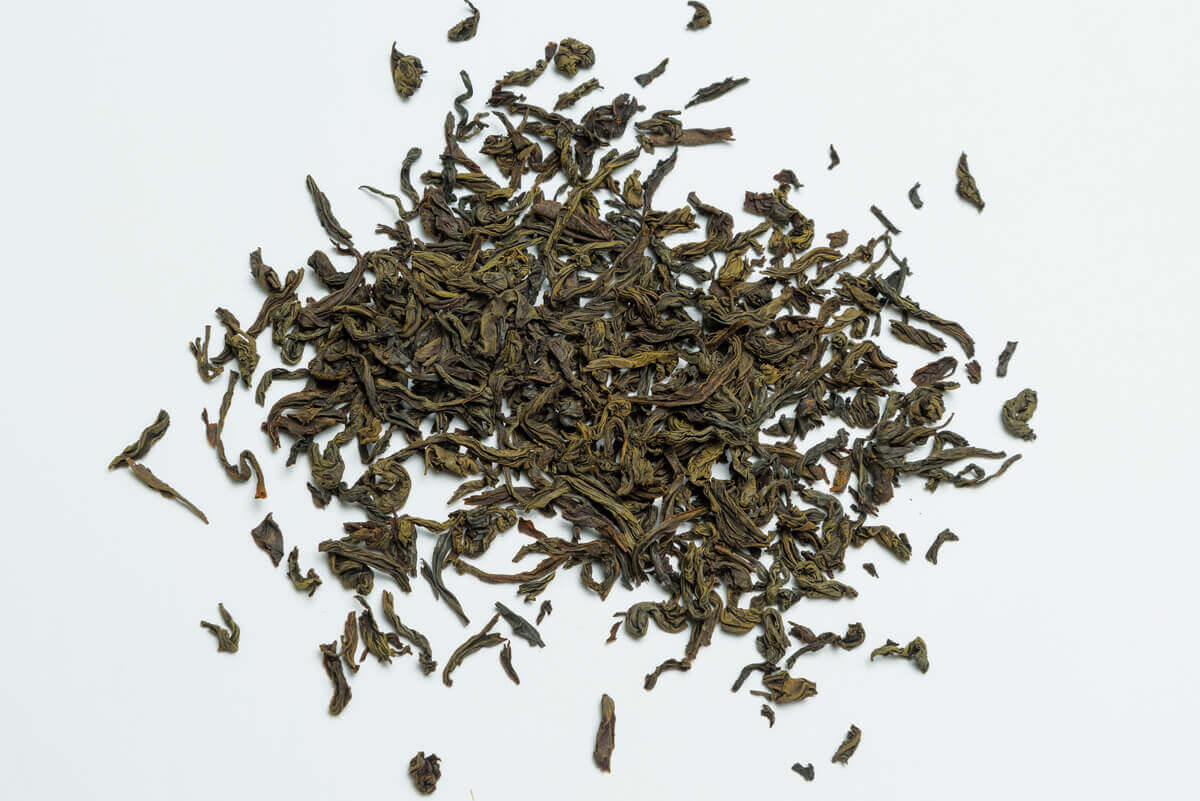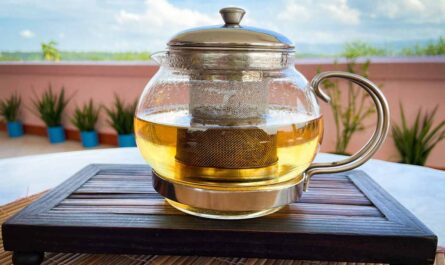What are some of Pouchong tea’s health benefits, its nutrition, recipes, & side effects? Pouchong tea emerges not merely as a beverage but as a symphony of wellness, each sip orchestrating a harmonious blend of health benefits. From the antioxidant overture to the gut microbiota symphony, this tea dances through the realms of physical, mental, and emotional well-being. As the cup is raised to lips, it becomes a toast to a life enriched by the intricate melodies woven by the enchanting elixir that is Pouchong tea. In this article, we will share some of Pouchong tea’s health benefits, nutrition, recipes, & side effects. Keep reading.
Pouchong tea, a semi-fermented tea hailing from Taiwan, boasts a delicate flavor profile that sits between green and oolong tea. Despite its popularity for its unique taste, it’s imperative to delve into the potential side effects that may accompany its consumption. These side effects, although relatively uncommon, merit consideration for individuals sensitive to certain compounds present in the tea.
Nutritional facts of Pouchong tea
In the world of teas, Pouchong stands as a testament to the delicate artistry of tea crafting. From its origins in Taiwan to the nuanced brewing process, from its aromatic allure to its culinary adaptability, Pouchong tea weaves a narrative of flavor, tradition, and sustainability. Each cup is not just a beverage; it’s a journey through time, a celebration of culture, and a symphony of senses. As tea enthusiasts continue to explore the vast landscape of teas, Pouchong remains a shining gem, inviting all to savor its complexities and indulge in the unparalleled experience it offers.
Origins and Processing
Pouchong tea, hailing from Taiwan, boasts a rich history deeply rooted in the island’s tea culture. The term “Pouchong” itself translates to “the wrapped kind,” an apt descriptor for the unique processing method employed in crafting this tea. Harvested from the Camellia sinensis plant, the leaves undergo a partial fermentation process, falling between green and oolong tea categories. This meticulous processing imparts a delicate flavor profile to Pouchong, setting it apart in the world of teas.
Aromatic Symphony
A distinctive attribute of Pouchong tea lies in its captivating aroma, an olfactory symphony that dances between floral and fruity notes. The leaves, skillfully handpicked and processed, retain their natural oils, releasing a fragrance that tantalizes the senses. Hints of jasmine, orchid, and tropical fruits intertwine, creating an aromatic experience that transcends the mere act of drinking tea. The infusion process further amplifies these fragrances, turning every cup into a sensory journey.
Brewing Mastery
Achieving the perfect cup of Pouchong tea requires a delicate dance of time and temperature. The leaves, unfurling gracefully during brewing, demand precision in steeping. A slightly lower water temperature, around 185°F (85°C), and a short infusion time of 2-3 minutes bring forth the nuanced flavors without overpowering the subtleties. The art of brewing Pouchong lies in this careful calibration, allowing tea enthusiasts to savor the intricate dance of flavors without compromise.
Culinary Versatility
Pouchong tea’s versatility extends beyond the teapot, finding its way into culinary delights. From infused desserts to savory dishes, this tea’s nuanced flavor profile lends itself well to experimentation in the kitchen. Imagine Pouchong-infused ice creams, delicate sauces, or even marinated meats. The tea’s ability to complement both sweet and savory elements opens up a world of gastronomic possibilities, making it a favorite not only among tea enthusiasts but also among creative chefs seeking to elevate their culinary creations.
Cultural Significance
Beyond its gustatory delights, Pouchong tea holds cultural significance deeply embedded in Taiwanese traditions. Often served during special occasions and ceremonies, this tea becomes a conduit for shared experiences and connections. The art of brewing and enjoying Pouchong is a ritual, a communal practice that fosters bonds and transcends generational divides. In each sip, there echoes a cultural legacy, making Pouchong more than just a beverage—it’s a bridge to the past and a celebration of the present.
Sustainability and Ethical Sourcing
As awareness about sustainability grows, so does the emphasis on the sourcing practices of tea producers. Pouchong tea, with its roots firmly planted in Taiwan’s lush landscapes, often embraces eco-friendly and ethical cultivation methods. Many tea estates prioritize sustainable farming, minimizing environmental impact, and ensuring fair treatment of workers. This commitment to ethical sourcing adds another layer of value to the Pouchong experience, allowing consumers to partake in a beverage that not only delights the palate but also aligns with conscientious consumption.
Caffeine Content and Health Benefits
Pouchong tea strikes a harmonious balance when it comes to caffeine content, making it an ideal choice for those seeking a moderate energy boost without the jitteriness associated with stronger teas or coffee. Beyond its delightful taste and aroma, Pouchong offers a plethora of health benefits. Rich in antioxidants, it aids in neutralizing free radicals, potentially reducing the risk of chronic diseases. Additionally, the polyphenols present in Pouchong may contribute to improved heart health, making it not just a flavorful indulgence but a wellness elixir.
How much Pouchong tea to drink every day?
The enjoyment of Pouchong tea transcends mere beverage consumption; it is a sensory experience that invites enthusiasts to explore the subtleties of flavor and aroma. By embracing a mindful approach to brewing and balancing the quantity consumed, individuals can integrate this exquisite tea into their daily rituals, reaping both sensory and potential health benefits. Pouchong tea, a distinctive and lightly fermented oolong tea, offers a nuanced flavor profile and a delicate aroma that appeals to tea connoisseurs worldwide. To derive maximum enjoyment and potential health benefits from this exquisite tea, understanding the optimal daily consumption becomes pivotal.
Brewing Rituals and Pouchong Tea
Embarking on a sensory journey with Pouchong tea involves mastering the art of brewing. Delicate leaves skillfully rolled and partially oxidized, unfurl to release a symphony of floral and fruity notes. A meticulous brewing ritual requires precision in water temperature and steeping time, ensuring the preservation of the tea’s intrinsic qualities. A gentle touch and a discerning palate are the keys to unlocking the full spectrum of flavors Pouchong tea has to offer.
Potential Health Benefits
Beyond its enchanting flavor, Pouchong tea boasts potential health benefits that underscore its status as more than a mere beverage. Rich in antioxidants, this tea variety may contribute to cellular health and bolster the immune system. The moderate caffeine content can provide a gentle energy boost without the jarring effects associated with stronger caffeinated beverages. However, it is imperative to view Pouchong tea as a supplement to a well-rounded, healthy lifestyle rather than a panacea.
Individual Factors and Moderation
Individual responses to caffeine and tea constituents can vary widely. Factors such as age, overall health, and pre-existing medical conditions should be considered when determining the ideal daily intake of Pouchong tea. Consulting with healthcare professionals can provide personalized insights, ensuring that tea enthusiasts tailor their consumption to align with their unique physiological needs and preferences.
Savoring the Nuances
Pouchong tea enthusiasts often revel in the nuanced layers of taste that this tea variety unfolds. The subtle interplay of floral undertones and the hint of natural sweetness can be truly appreciated when consumed mindfully. Savvy tea drinkers might find joy in experimenting with different brewing methods and adjusting variables to tailor the flavor profile to their preferences. Whether relishing it in solitude or sharing the experience with others, Pouchong tea becomes an invitation to savor the finer aspects of life.
Balancing Act: Quantity Matters
While the allure of Pouchong tea may tempt one to indulge, striking a balance in daily consumption is crucial. Optimal intake varies among individuals, influenced by factors such as personal tolerance to caffeine and individual health considerations. Experts suggest a moderate approach, recommending two to three cups per day as a reasonable guideline. This measured consumption allows enthusiasts to relish the tea’s essence without overwhelming the system, fostering a harmonious relationship between the tea and its imbibers.
What is the best time to drink Pouchong tea?
Pouchong tea transcends mere beverage status, evolving into a temporal elixir that adapts to the ebb and flow of moments, seasons, and emotions. Whether savored in the hush of dawn, the quietude of twilight, or the buzz of midday, Pouchong’s allure remains undiminished, a testament to its timeless appeal. As you embark on your Pouchong journey, consider not just the tea leaves but also the symphony of time that accompanies each exquisite sip.
A Symphony of Seasons: Pouchong’s Affinity with Nature’s Rhythms
Beyond the ticking hands of the clock, Pouchong tea harmonizes exquisitely with the changing seasons, creating a dynamic tapestry of flavors that evolve throughout the year. Spring, with its awakening energy, imparts a vibrancy to the tea, accentuating its floral notes. Summer brings forth a refreshing zest, making Pouchong an ideal companion for warmer days. The crispness of autumn air enhances the tea’s earthy undertones, while winter invites a comforting warmth, transforming each sip into a cozy embrace. Understanding the interplay between Pouchong and the seasons adds another layer of depth to the tea-drinking experience, allowing enthusiasts to appreciate its nuanced evolution with nature’s ever-shifting cadence.
Optimal Moments for Indulging in Pouchong Tea Pleasure
Embarking on the delightful journey of savoring Pouchong tea involves more than just selecting a brew; it necessitates a nuanced understanding of the temporal nuances that enhance its flavor profile. The nuanced balance between celestial bodies and earthly elements significantly impacts the sensory symphony that unfolds with each sip. As the sun ascends the sky, casting its warm embrace upon the world, the morning emerges as a prime canvas for the tea aficionado. The first rays of daylight, akin to a gentle caress, coax the delicate aromas of Pouchong leaves into a harmonious dance. This golden hour, where dawn meets day, unveils the true essence of the tea, a subtle orchestration of floral notes, and a hint of sweetness. The stillness of the early hours creates an ambiance that allows one to attune their senses to the intricate nuances of this Taiwanese gem.
Soothing Twilight Rituals: Unveiling the Evening Symphony of Pouchong
As the sun gracefully descends beyond the horizon, relinquishing its hold on the day, another opportunity arises for the Pouchong connoisseur to partake in a ritualistic evening indulgence. The twilight hours, bathed in a soft palette of colors, usher in a serene calmness that complements the tea’s inherent tranquility. The leaves, having absorbed the day’s sunlight, release their essence, weaving a tale of nature’s alchemy within the teapot. The evening cup of Pouchong, akin to a poetic sonnet, unfolds gradually, revealing layers of complexity that mirror the interplay between dusk and night. A symphony of flavors dances on the palate, from the subtle earthiness to the lingering sweetness that marks the end of the day.
Versatility Amidst the Clock’s Hands: Pouchong’s Timeless Appeal
In the realm of Pouchong appreciation, one cannot be tethered solely to the conventions of morning and evening. This tea, with its versatile character, transcends temporal boundaries, offering a gratifying experience throughout the day. The midday respite, marked by the sun’s zenith, presents an opportune moment for a refreshing interlude. Pouchong’s inherent lightness and floral notes provide a rejuvenating accompaniment to the lunchtime reprieve. Additionally, the tea seamlessly adapts to social settings, becoming a companion for conversations, contemplation, or moments of solitude. Its adaptability to various moments throughout the day underscores its status as a beverage that defies temporal constraints, ensuring a delightful experience whenever one chooses to indulge.
Health benefits of Pouchong tea
Pouchong tea, a tantalizing brew nestled between green and oolong varieties, captivates the senses with its delicate aroma and nuanced flavor profile. Renowned for its distinctive floral notes and a hint of fruitiness, this tea variety emerges as a beacon of health and wellness. As we embark on an exploration of the health benefits bestowed by Pouchong tea, a tapestry of benefits unfolds, weaving together the rich tapestry of its consumption. Here are some of the health benefits of Pouchong tea:
How to Make Pouchong Tea
In the serene moments of tea preparation and consumption, savoring Pouchong becomes a ritual of delight. As the leaves gracefully unfurl in hot water, they release a fragrant mist that transports enthusiasts to the lush hillsides of Taiwan. The pale green liquor that graces the cup is a visual testament to the finesse involved in every step of Pouchong tea production. With each sip, one embarks on a sensory journey, exploring the interplay of floral, fruity, and herbaceous notes that define this extraordinary tea. Savoring Pouchong is not just an act; it is an invitation to appreciate the artistry and nature’s bounty encapsulated within every delicate leaf.
Harvesting and Selecting Fine Pouchong Tea Leaves
In the verdant landscapes of Taiwan, where lush tea plantations sprawl across undulating hills, the meticulous process of crafting Pouchong tea begins with the careful harvesting and selection of tea leaves. Cultivated from the Camellia sinensis plant, the leaves destined for Pouchong tea boast a delicate yet distinct character. Expert tea pickers, and birdwatchers with a nuanced understanding of the ideal plucking time, gingerly gather the young leaves, ensuring their optimal freshness and tenderness. This initial step lays the foundation for the tea’s nuanced flavor profile.
Crafting a Symphony of Aromas: The Art of Withering
Once the leaves are harvested, the next pivotal stage in Pouchong tea production is the artful process of withering. This delicate dance between nature and craftsmanship involves exposing the leaves to controlled levels of sunlight, allowing them to gently wilt. The withering phase is orchestrated with precision, ensuring the leaves release their unique bouquet of aromas. The tea artisans monitor temperature, humidity, and airflow, coaxing out the nuanced fragrance that distinguishes Pouchong tea. It is during this stage that the leaves begin their transformative journey, unveiling layers of floral and fruity notes.
Skillful Oxidation: Enhancing Complexity and Depth
Oxidation, a pivotal phase in the production of various teas, is a nuanced art in the crafting of Pouchong. Unlike heavily oxidized teas, Pouchong undergoes a lighter oxidation process, striking a delicate balance that preserves its inherent freshness. Skilled artisans carefully control the level of oxidation to enhance the tea’s complexity and depth without overshadowing its natural vibrancy. This stage is crucial in unlocking the tea’s distinctive character, allowing it to flirt gracefully between the realms of green and oolong tea, rendering Pouchong a category unto itself.
Rolling and Shaping: A Dance of Precision
The dance of precision continues as the withered and oxidized leaves undergo a meticulous rolling and shaping process. Executed with utmost care, this step imparts a unique appearance to Pouchong tea, with tightly curled leaves resembling tiny scrolls. The careful rolling not only refines the tea’s visual allure but also influences its steeping characteristics. Each leaf, now intricately shaped, harbors the potential to unfurl in hot water, releasing a symphony of flavors and aromas that have been patiently cultivated through each prior step in the journey.
Final Touch: Drying and Sealing the Essence
The culmination of the Pouchong tea crafting process involves a final touch, where the meticulously shaped leaves are subjected to a controlled drying process. This step not only preserves the tea but also sets the stage for its journey from plantation to teapot. The leaves, now infused with the essence of careful craftsmanship, are sealed in airtight containers, ensuring that every cup brewed captures the essence of the Taiwanese terroir. This final touch is a testament to the dedication of those who transform humble tea leaves into an elixir that transcends time and borders.
Side effects of Pouchong tea
Caffeine Sensitivity
For those particularly susceptible to caffeine’s effects, Pouchong tea may pose a challenge. While its caffeine content is lower compared to black tea, it still contains a significant amount that could trigger restlessness, insomnia, or even heightened anxiety in those with heightened sensitivity. Individuals prone to migraines or certain cardiovascular issues may also want to monitor their intake, as excessive caffeine can exacerbate these conditions.
Interactions with Medications
Pouchong tea contains compounds that can interfere with certain medications. The polyphenols in tea, for instance, can hinder the absorption of iron. Individuals with iron-deficiency anemia or those on iron supplements should be vigilant about the timing of their tea consumption. Additionally, anyone taking medications for blood pressure regulation or anticoagulants should consult their healthcare provider, as the vitamin K content in Pouchong tea may affect the efficacy of these medications.
Pregnancy Considerations
Pregnant individuals often face dietary restrictions, and Pouchong tea should be approached with caution. While moderate tea consumption is generally considered safe during pregnancy, the caffeine content and potential contaminants in tea leaves warrant careful consideration. High caffeine intake during pregnancy has been linked to adverse outcomes, including preterm birth and low birth weight. Therefore, pregnant individuals should consult their healthcare provider before incorporating Pouchong tea into their diet.
Gastrointestinal Distress
The fermentation process of Pouchong tea involves various microbial actions that can result in the formation of compounds like histamine. For some individuals, histamine can be a trigger for gastrointestinal discomfort, causing symptoms such as bloating, nausea, or abdominal pain. It’s crucial for those with pre-existing gastrointestinal conditions, like irritable bowel syndrome (IBS), to be aware of these potential effects and consume Pouchong tea in moderation. Tea, Coffee, Energy Drinks, Juice, Beverage, Smoothie, and more
Allergic Reactions
Allergies to tea are rare, but not impossible. Pouchong tea, derived from Camellia sinensis leaves, shares allergenic proteins with other teas. Individuals with a known allergy to tea or related plants may experience allergic reactions such as itching, hives, or even more severe responses like anaphylaxis. It’s paramount for those with known allergies to exercise caution and consult with a healthcare professional before indulging in Pouchong tea.
More Interesting Articles
- Secrets Why Japanese Green Tea is Good for Health
- How Drinking Green Tea Can Help Lower Cholesterol
- What is the Best Water to Make Tea or Coffee at Home?
- Health Benefits of Drinking Black Coffee vs Green Tea
- Green Tea for Acne Treatment: Benefits, Uses, Forms
- 9 Great Health Benefits of Matcha Green Tea Powder
- 5 Tips on How to Make Iced Tea with Tea Bags Instantly
- 33 Health Benefits of Drinking Green Tea in the Morning
- 20 Great Health Benefits of Lemongrass and Ginger Tea
- Matcha Green Tea Powder All Natural Weight Loss Metabolism Booster And Diet
- 15 Hibiscus Tea Proven Benefits with Some Side Effects
- 12 Benefits of Chamomile Tea in Weight Loss & More
- 17 Incredible Blue Butterfly Pea Flower Tea Health Benefits
- Teavana Peach Citrus White Tea Facts To Know Well
- 23 Healthy Benefits of Drinking Chamomile Tea Daily
- 9 Healthy Benefits of Drinking Green Tea for Skin & Hair
- 5 Tips On How to Start Exercising When You’re Out of Shape
- 10 Home Remedies for Cold and Flu with Headache
- 11 Proven Health Benefits of Japanese Sencha Green Tea
- 15 Drinking Too Much Tea Side Effects Backed By Science




